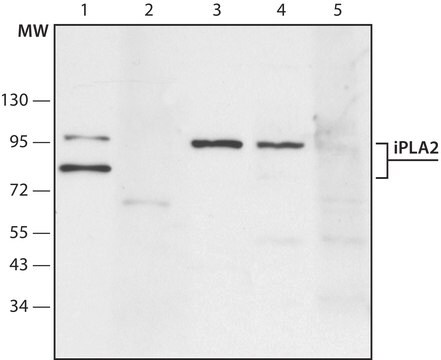推荐产品
生物源
mouse
品質等級
抗體表格
purified antibody
抗體產品種類
primary antibodies
無性繁殖
CH-7, monoclonal
製造商/商標名
Chemicon®
技術
ELISA: suitable
western blot: suitable
同型
IgG2b
NCBI登錄號
UniProt登錄號
運輸包裝
wet ice
目標翻譯後修改
unmodified
特異性
Antibody reacts with cytosolic form of PLA2. Antibody will also react with beta isoform. Epitope has been localized within the first 216 aa of the N-terminal Ca++ binding domain of cPLA2
免疫原
Recombinant cPLA2 expressed from the human cPLA2 gene.
應用
Detect Phospholipase A2 using this Anti-Phospholipase A2 Antibody, clone CH-7 validated for use in ELISA & WB.
Immunoblot: 1:500-1:1000; antibody recognizes all isoforms, the cPLA.
Alpha (85kDa) typically migrates as 100-110kDa on reducing westerns; beta migrates as 114kDa; antibody will also recognize the sPLA at approximately 14-20kDa.
ELISA
Optimal working dilutions must be determined by the end user.
Alpha (85kDa) typically migrates as 100-110kDa on reducing westerns; beta migrates as 114kDa; antibody will also recognize the sPLA at approximately 14-20kDa.
ELISA
Optimal working dilutions must be determined by the end user.
Research Category
Signaling
Signaling
Research Sub Category
Lipid Signaling
Lipid Signaling
外觀
Format: Purified
In 20 mM sodium phosphate, 250 mM sodium chloride, 0.1% sodium azide, pH. 7.6
儲存和穩定性
Maintain at 2-8°C.
其他說明
Concentration: Please refer to the Certificate of Analysis for the lot-specific concentration.
法律資訊
CHEMICON is a registered trademark of Merck KGaA, Darmstadt, Germany
免責聲明
Unless otherwise stated in our catalog or other company documentation accompanying the product(s), our products are intended for research use only and are not to be used for any other purpose, which includes but is not limited to, unauthorized commercial uses, in vitro diagnostic uses, ex vivo or in vivo therapeutic uses or any type of consumption or application to humans or animals.
Not finding the right product?
Try our 产品选型工具.
儲存類別代碼
10 - Combustible liquids
水污染物質分類(WGK)
WGK 2
閃點(°F)
Not applicable
閃點(°C)
Not applicable
Tian Sheng Chen et al.
Nucleic acids research, 38(1), 215-224 (2009-10-24)
Intercellular exchange of protein and RNA-containing microparticles is an increasingly important mode of cell-cell communication. Here we investigate if mesenchymal stem cells (MSCs) known for secreting therapeutic paracrine factors also secrete RNA-containing microparticles. We observed that human embryonic stem cell
Clive Bate et al.
The Journal of biological chemistry, 291(1), 160-170 (2015-11-11)
The prion diseases occur following the conversion of the cellular prion protein (PrP(C)) into disease-related isoforms (PrP(Sc)). In this study, the role of the glycosylphosphatidylinositol (GPI) anchor attached to PrP(C) in prion formation was examined using a cell painting technique.
Clive Bate et al.
BMC biology, 6, 39-39 (2008-09-16)
The transmissible spongiform encephalopathies, otherwise known as prion diseases, occur following the conversion of the cellular prion protein (PrPC) to an alternatively folded, disease-associated isoform (PrPSc). Recent studies suggest that this conversion occurs via a cholesterol-sensitive process, as cholesterol synthesis
Clive Bate et al.
The Journal of biological chemistry, 286(11), 8752-8758 (2011-01-08)
Prion diseases occur following the conversion of the cellular prion protein (PrP(C)) into a disease related, protease-resistant isoform (PrP(Sc)). In these studies, a cell painting technique was used to introduce PrP(C) to prion-infected neuronal cell lines (ScGT1, ScN2a, or SMB
我们的科学家团队拥有各种研究领域经验,包括生命科学、材料科学、化学合成、色谱、分析及许多其他领域.
联系技术服务部门








